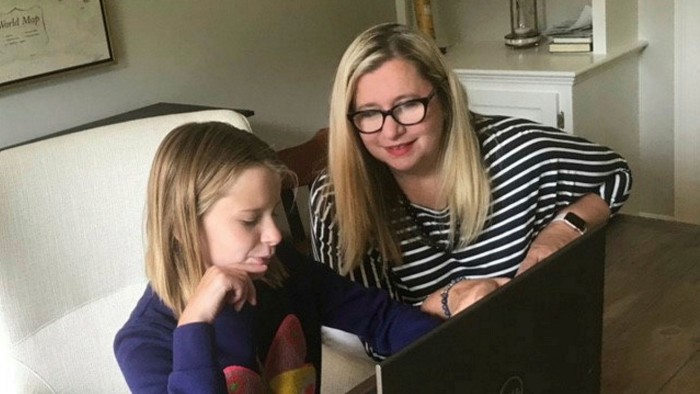Pandemic reverses progress on workplace equality

Roula Khalaf, Editor of the FT, selects her favourite stories in this weekly newsletter.
When Covid-19 started closing offices and schools across the world early this year, Kristi Hummel soon found she had a tricky second job: teaching maths to her nine-year-old daughter.
It might not have been a problem if she did not have a big first job, senior vice-president for talent and culture at Dell Technologies, the US technology group. “It did not go so well,” she tells the Financial Times from her home outside Boston.
By September though, things were looking up. Dell brought in new benefits for parents, including a 20 per cent discount on tutoring fees.
Ms Hummel hired a maths tutor to come in twice a week, a step that has delighted both her and her daughter. “We are very excited about it,” she says, adding she is especially relieved she no longer had to “do double duty as a math teacher”.
Dell is one of many large companies offering extra help to parents struggling with the new world of remote working. That is proving vital for one parent in particular: mothers.
A growing body of research shows mothers and fathers are experiencing the pandemic in very different ways.
Mothers of primary school children have spent an average of five hours a day on home schooling, while fathers spent two hours, a study by UCL in the UK revealed. Just over 60 per cent of working mothers said they mostly handled childcare, compared with 42 per cent of fathers, another survey, by job search website FlexJobs, last month found.
It showed 80 per cent of mothers also said they took the lead on remote learning, versus 31 per cent of fathers. Unsurprisingly, 17 per cent of mothers had quit their jobs, compared with 10 per cent of fathers.
Unhappily, not everyone can work for a company such as Dell, which has a long history of flexible working and had nearly a third of its staff working remotely on any given day before the pandemic struck.
Some smaller companies have also taken notable steps, however.
Chegg, the Silicon Valley online learning group, offered up to $1,000 for childcare at the start of the outbreak so staff did not have to juggle parenting duties as they set up home offices.
“Then as things went along, we realised that children were getting bored and parents were getting anxious,” says Debra Thompson, Chegg’s chief people officer. So the company started offering its 1,600 employees online music classes, a computer coding camp and other activities.
Noticing its workers were growing stressed by long hours, it decided to let them stop work after 2pm on Fridays, then take all of Friday off, plus a week off for the July 4 holiday.
“I was shocked,” says Jennie Vega, a Chegg executive assistant who has three children under the age of 11 and found the Friday break invaluable. “I was able to give undivided attention to my children,” she says. “I felt they were a little bit better behaved.”
The day off arrangement ended last month but the group now has “no-meetings Fridays” instead and hopes to give staff another $1,000 towards childcare. Overall, Ms Vega feels the company has been “super generous”, and she has a point.

A recent study of 228 global organisations found a third had no formal policies to support parents and carers trying to juggle work with family responsibilities. Although 79 per cent said they had increased support for flexible working, 36 per cent said they had no specific policies to consistently deal with short-term flexible working needs during the pandemic. More than a quarter were not actively planning for parents who chose not to send children back to school because of fears about a lack of social distancing.
“Worryingly, our research shows that the pandemic is undoing some of the progress made towards equality in the workplace,” says James Tarbit, a managing director at employee research group Karian and Box, which carried out the study with the Global Institute for Women’s Leadership at King’s College London.
The situation may be about to worsen. With the threat of more job losses looming, Julia Gillard, the former Australian prime minister who chairs the institute, says the decisions businesses make in coming months must not disadvantage the carers who have been doing most to help others.
“By failing to take into account these pressures when considering performance reviews and redundancies, we run the risk of penalising those who have shouldered the greatest burden, many of whom will be women,” she says.
So what should companies be doing, especially if they lack the financial firepower of big groups such as Dell, which has 165,000 employees, or
Bank of America, which has about 212,000?
Bank of America also offers staff help with tutoring and online classes, on top of an eye-catching payment of up to $100 a day for childcare. It has provided more than 1m days of care by August, accounting for more than $100m in reimbursements, and is extending support until December.
Katy Ingle, the bank’s head of diversity and inclusion for Europe, the Middle East and Africa, says not all measures need be expensive.
“Some of the things that we have done were not costly but they certainly helped,” she says, explaining that guides were drawn up early in the pandemic to show what resources were available inside and out of the bank to managers.
There was also advice on how to have empathetic conversations — or difficult ones — with far-flung team members. This may not sound as exciting as generous childcare payments or subsidised tutoring but helping frontline managers deal with the pressures working mothers face is still vital. Ms Ingle says: “We are in an unprecedented environment.” And it appears this will be the case for many months to come.
Comments